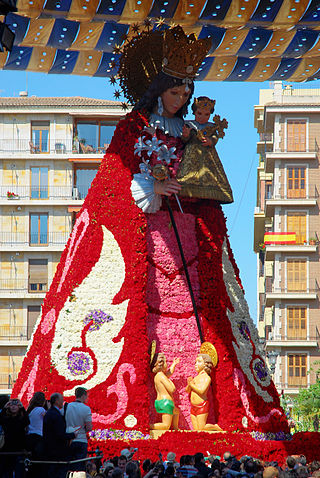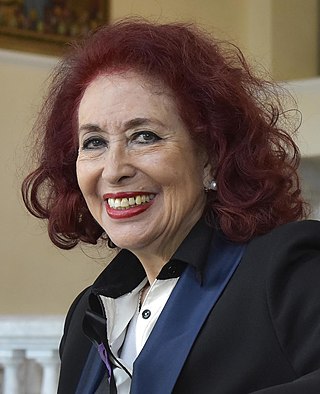Related Research Articles

Valencia is the capital of the province and autonomous community of the same name. It is the third-most populated municipality in Spain, with 807,693 inhabitants (2023) within the Ciudad de Valencia and 1,582,387 inhabitants (2021) within metropolis of the Huerta de Valencia. It is located in eastern Spain, on the banks of the Turia, on the east coast of the Iberian Peninsula on the Mediterranean Sea.
Lusitanian mythology is the mythology of the Lusitanians, an Indo-European speaking people of western Iberia, in what was then known as Lusitania. In present times, the territory comprises the central part of Portugal and small parts of Extremadura and Salamanca.

Tartessian is an extinct Paleo-Hispanic language found in the Southwestern inscriptions of the Iberian Peninsula, mainly located in the south of Portugal, and the southwest of Spain. There are 95 such inscriptions, the longest having 82 readable signs. Around one third of them were found in Early Iron Age necropolises or other Iron Age burial sites associated with rich complex burials. It is usual to date them to the 7th century BC and to consider the southwestern script to be the most ancient Paleo-Hispanic script, with characters most closely resembling specific Phoenician letter forms found in inscriptions dated to c. 825 BC. Five of the inscriptions occur on stelae that have been interpreted as Late Bronze Age carved warrior gear from the Urnfield culture.

The Via Augusta was the longest and busiest of the major roads built by the Romans in ancient Hispania. According to historian Pierre Sillières, who has supervised excavation of Roman sites in Spain to identify the exact route followed by the Via Augusta, it was more a system of roads than a single road. Approximately 1,500 km (930 mi) long, the Via Augusta was built to link Spain with Italy, running from the southwestern coastal city of Gades (Cádiz) to the Pyrenees Mountains along inland valleys parallel to the coast of the Mediterranean Sea. As the main axis of the road network in Roman Hispania, it appears in ancient sources such as the itinerary inscribed on the Vicarello Cups as well in as the Antonine Itinerary.
María de Estrada was a Spanish woman who was part of the expedition of Hernán Cortés to Mexico in 1519–24. She traveled as a conquistador and fought there. There is also some evidence that she had previously spent several years as a castaway among the native inhabitants of pre-colonial Cuba.

Arroz a la valenciana or Valencian rice is a name for a multitude of rice dishes from diverse cuisines of the world, which originate from the rice-cooking tradition of the Valencian Community, in eastern Spain.

Our Lady of the Forsaken is a Catholic invocation of the Virgin Mary. She is the patroness of Valencia and one of seven patrons of the Autonomous communities of Spain. She appears with a lily in one hand and in the other, she carries the baby Jesus who bears the cross in his arms. Her posture is characterized by a slight forward tilt, and hence, she is known affectionately as the Geperudeta (hunchback) of València. Her image is housed in the 'Basilica de la Mare de Déu dels Desamparats'.

María de la Concepcion Aleixandre Ballester, also known as Maria de la Concepcion Isidra Faustina Stephanie Vicenta, was a Spanish teacher, medical doctor, gynecologist, inventor, scientist, and writer. She was the first woman admitted to Spain's Gynecological Society.
Alicia Marín Martínez is a Spanish recurve archer.

The history of Valencia, one of the oldest cities in Spain, begins over 2100 years ago with its founding as a Roman colony under the name "Valentia Edetanorum" on the site of a former Iberian town, by the river Turia in the province of Edetania. The Roman consul Decimus Junius Brutus Callaicus transferred about 2,000 veteran soldiers who had fought under him to Valentia in 138 BC. Valentia lay in a strategic location near the sea on a river island that would later be crossed by the Via Augusta. Pompey razed Valentia to the ground in 75 BC; it was rebuilt about fifty years later with large infrastructure projects, and by the mid-1st century, was experiencing rapid urban growth with many colonists from Italy.

Sagunto Castle is a fortress overlooking the town of Sagunto, near Valencia in Spain. The site's history extends back over two thousand years and includes Iberian, Roman and medieval remains. During the Islamic period, the castle was known as Murbĩtar and Morvedre. The castle was declared a National Monument in 1931.

Monumento a la Mujer is a bronze statue commemorating the contributions of the Puerto Rican women to the Puerto Rican society. It is located at the fork of Calle Marina and Calle Mayor Cantera, in Ponce, Puerto Rico, next to Parque Urbano Dora Colón Clavell, in Barrio Cuarto. It was unveiled in 2002. Its sculptor was Maria Elena Perales. The monument was the first and, at the time, the only one of its kind "in Puerto Rico and the Caribbean."

Cristina Bucșa is a Moldovan-born Spanish professional tennis player. She has career-high rankings of world No. 56 in singles, achieved on 15 January 2024, and of No. 20 in doubles, achieved on 27 May 2024.

Lidia Falcón O'Neill is a Spanish politician and writer. With a degree in law, dramatic art, and journalism, and a PhD in philosophy, she has stood out for her defense of feminism in Spain, especially during the Transition.
Nacéra Benseddik is an Algerian historian, archaeologist and epigrapher. She was born in Bordj Bou Arreridj on 4 December 1949.

Irene Burillo Escorihuela is a Spanish professional tennis player. She has career-high WTA rankings of world No. 207 in singles, achieved on January 2022, and No. 272 in doubles, achieved on 7 August 2023. She has won four singles titles and seven doubles titles on the ITF Circuit.

The gens Viria was a Roman family of the second and third centuries, possibly of northern Italian origin. The first member to ascend the cursus honorum was Virius Lupus, who attained the consulship in the late second century. It is possible that the family was elevated to patrician status around that time. The family's influence reached its apex during the third century.

Alma Jane Valencia Escoto is a Mexican freestyle wrestler. In the 55 kg category, she won the silver medal at the 2015 Pan American Games, having finished seventh in 2011. She won three bronze medals at the Pan American Wrestling Championships in 2010, 2011 and 2013. She also won a silver and gold medal at the 2010 and 2014 Central American and Caribbean Games respectively, both in the 55 kg category.
Bibiane Gabrielle "Bibi" Schulze Solano is a German professional footballer who plays as a centre back for Spanish Liga F club Athletic Bilbao and the Germany national team. Born and raised in Germany, she is of Basque heritage on her mother's side and was called up for the Spain national squad in 2023.

Mónica Ferrández Arenas is a Spanish rhythmic gymnast and trainer. She's a European and World medalist.
References
- ↑ S.L, EDICIONES PLAZA. "Viria Acte, la esclava romana que cambió la escultura en València". Cultur Plaza (in Spanish). Retrieved 2024-01-11.
- ↑ "Víria Acte" [Biographical Dictionary of Woman]. Diccionari Biogràfic de Dones (in Catalan). Archived from the original on 2014-12-09. Retrieved 2024-01-11.